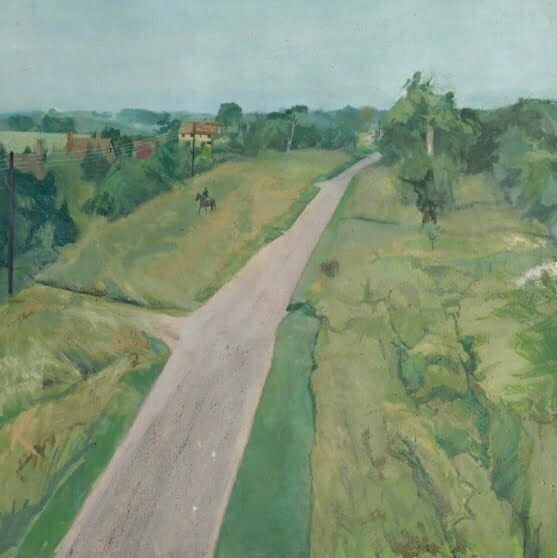
Contrary to conventional wisdom, I like to judge a book by its cover. If the cover looks good, then the results inside tend to be good also. The better the content, the more inspired the jacket designer must feel. Certainly this has been my rule when judging the use of paintings for book covers. I gained my initial education in art thanks to the paintings used for the covers of Penguin classics, marvelling at the breadth of knowledge that the designers must possess, and the usual (if not quite unerring) accuracy with which they match image to theme. The image’s potency had to last for the length of time that it took you to read the book, and usually it did. Frank Weston Benson’s ‘Rainy Day’ on the cover of Henry James’ Washington Square, Jack Yeats’ ‘The Bus by the River’ for Flann O’Brien’s At Swim-Two-Birds, Max Ernst’s ‘The Eye of Silence’ for Herbert Read’s The Green Child, Mary Cassatt’s ‘Two Sisters’ for The Penguin Book of Women Poets – classic combinations all.
One book cover that especially haunted me was that for the Penguin Book of Contemporary British Poetry, edited by Blake Morrison and Andrew Motion in 1982. The painting was ‘Lights VII: a Shadow’, by Michael Andrews. It shows the shadow of a balloon on a beach with the sea and sky beyond, as viewed from the balloon itself. Its mystery, modernity, and sense of the observer observed, all matched the contents of the volume perfectly.
The painting I now know was one of a series of seven balloon-themed works by Andrews, entitled Lights (in homage to Rimbaud’s Les Illuminations), thanks to an exhibition of Andrews’ late works, now on at the Gagosian gallery in Mayfair, London. I also know that I am not the only person who was transfixed by the painting’s use on the poetry book cover, as Jonathan Jones in his Guardian review of the exhibition, ‘Adrift in a dreamworld – the genius of Michael Andrews makes us doubt our own eyes‘, admits to the same inspiration.

Michael Andrews (1928-1995) was a British painter whose talent appears all the more singular the more you contemplate his art, certainly these works from the last twenty-five years of his career. His subjects are ordinary and traditional – landscapes mostly – but they have this peculiar quality that makes them earthly and unearthly at the same time. Partly this is due to the absence of people from most of them. Partly it was the particular technique that he employed. As the gallery’s notes explain, he employed “a spray gun and water-based acrylic paint, allowing him to cover the canvas with large expanses of a single color, from airy and atmospheric to intense and saturated.” But such explanations are never enough. There is something in them, making the ordinary hallucinatory, that digs deep into us, making the everyday world we inhabit feel all the stranger for the experience.
The exhibition is entitled ‘Earth Air Water’ (which could serve as a title for his balloon shadow painting). It is divided into three sections, one per element. ‘Earth’ features English landscapes, Scottish hillsides and views of Ayers Rock in Australia. Two scenes of Andrews’ home village of Saxlingham Nethergate in Norfolk, and a technically impressive high-angle view of the Vale of Pewey in Wiltshire stood out for me: model exercises in perspective and drawing out the visual interest in receding grassland, which demand contemplation. You keep looking at them to find something more, yet knowing that somehow something is being kept hidden from you.
‘Air’ is the centrepiece, with three of the Lights balloon paintings (and one study). They form the striking introduction to the exhibition, though the glass that fronts several of them is annoyingly reflective. ‘Lights VII: A Shadow’ occupies the far wall, all the more powerful for being full-size (Andrews’ painting lose some of their distinctive impact in reduction) – and not cropped, as I now realise it was for that Penguin book cover. Equally arresting is ‘Cabin’, which shows an aeroplane with land and sea below, viewed from above the aeroplane. It’s an impossible position for the artist to have taken, yet it looks so ordinary. It’s a banal view that all can understand yet none ever experience.

‘Water’ has some quite remarkable paintings of fish. They are both literal – the recreation of underwater effects is a technical marvel – and unearthly, with an effect that made me think of the symbolist painter Odilon Redon. One painting ‘School II: Pike and Roach’ is similar in its effect to ‘Cabin’: the pike poses prominently and obligingly in a way that pikes just don’t. As with ‘Earth’ and ‘Air’, the more you look on the ordinary, the more extraordinary it becomes.
There are some portrait and figurative paintings in the exhibition, which are less distinguished. We see something of the artists’ world that he knew (habitués of Soho’s Colony Room), but the main paintings succeed because such figures have been removed. The only people on view are the viewers, sometimes reflected in the glass, but kept always at a remove from pictures that keep their secrets to themselves.
‘Earth Air Water‘ runs at the Gagosian gallery, Grosvenor Hill, Mayfair, until 25 March 2017